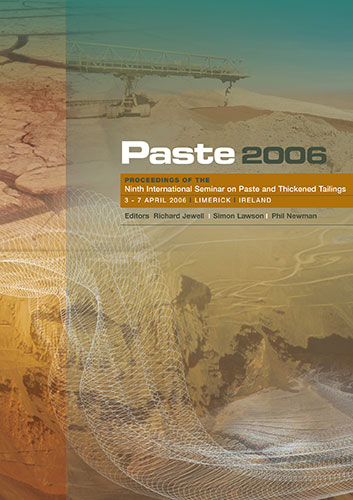Optimising Flocculation and Thickener Performance for Paste Disposal

|
Authors: Labbett, DM; Swift, JD; Austin, PJ; Heath, AR; Francis, NS; Livk, I; Fawell, PD; Farrow, JB; Bui, A; Rudman, M Paper is not available for download Contact Us |
DOI https://doi.org/10.36487/ACG_repo/663_4
Cite As:
Labbett, DM, Swift, JD, Austin, PJ, Heath, AR, Francis, NS, Livk, I, Fawell, PD, Farrow, JB, Bui, A & Rudman, M 2006, 'Optimising Flocculation and Thickener Performance for Paste Disposal', in R Jewell, S Lawson & P Newman (eds), Paste 2006: Proceedings of the Ninth International Seminar on Paste and Thickened Tailings, Australian Centre for Geomechanics, Perth, pp. 37-46, https://doi.org/10.36487/ACG_repo/663_4
Abstract:
The optimisation of thickener feedwells is often done to maximise throughput, i.e. achieving the best solids settling flux through control of flocculation conditions and feedwell hydrodynamics. Changes in feedwell design or the flocculant type, dosage and addition point can significantly alter the size of the aggregates formed by feedwell flocculation and hence their settling rates. However, the resultant aggregate properties also determine the solids fraction and rheology of the thickener underflow, and hence the propensity to produce paste behaviour for a given thickener design and operating conditions. A focus of the AMIRA P266D “Improving Thickener Technology” project was to understand the nature of aggregates formed within full-scale thickener feedwells and their relationship to throughput, overflow clarity and underflow density, through both laboratory studies and computational modelling (Farrow et al., 2000). Understanding how permeability and compressibility parameters vary with solids concentration is crucial to the modelling of thickener performance (Buscall and White, 1987). Despite this, there is little such information for slurries flocculated under carefully controlled conditions. This paper outlines the development of procedures to fully characterise these parameters and how they can be used to provide insight into the way underflow properties are affected by the initial flocculation conditions.
References:
Brassinga, R.D. and Fulford, G.D. (1986) Determination of specific thickener area requirements for synfloc-flocculated red muds
using a traversing gamma-radiation densitometer. Light Metals, pp. 51-59.
Buscall, R. and White, L.R. (1987) The consolidation of concentrated suspensions, part 1. – Theory of sedimentation. Chemical
Society: Faraday Transactions, 83, pp. 871-891.
Farrow, J.B. and Swift, J.D. (1996) A new procedure for assessing the performance of flocculants. Int. J. Mineral Process., 46, pp.
263-275.
Farrow, J.B., Fawell, P.D., Johnston, R.R.M., Nguyen, T.B., Rudman, M., Simic, K. and Swift, J.D. (2000) Recent developments in
techniques and methodologies for improving thickener performance. Chem. Eng. J., 80, pp. 149-155.
Gaudin, A.M. and Fuerstenau, M.C. (1958) The Transviewer – X rays to measure suspended solids concentrations. Eng. Mining J.,
159(9), pp. 108-112.
Kahane, R.B., Schwarz, M.P. and Johnston, R.R.M. (2002) Residue thickener modelling at Worsley Alumina. Appl. Math.
Modelling, 26, pp. 281-296.
Richardson, J.F. and Zaki, W.N. (1955) Sedimentation and fluidisation. Trans. Instn. Chem. Engrs., 32, pp. 35-53.
46 Paste2006,Limerick,Ireland
OptimisingFlocculationandThickenerPerformance… D.M.Labbett,etal.
© Copyright 2025, Australian Centre for Geomechanics (ACG), The University of Western Australia. All rights reserved.
View copyright/legal information
Please direct any queries or error reports to repository-acg@uwa.edu.au
View copyright/legal information
Please direct any queries or error reports to repository-acg@uwa.edu.au